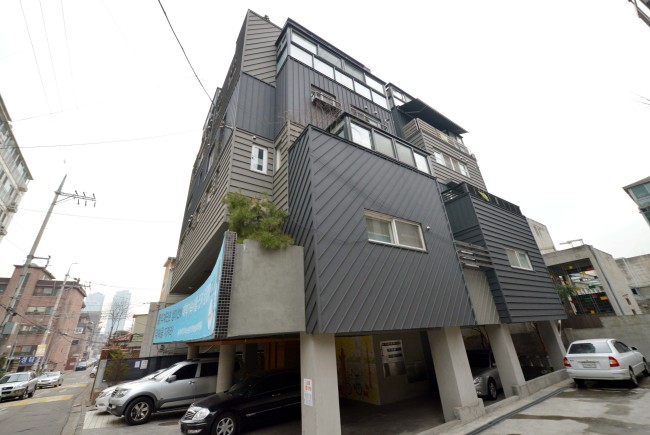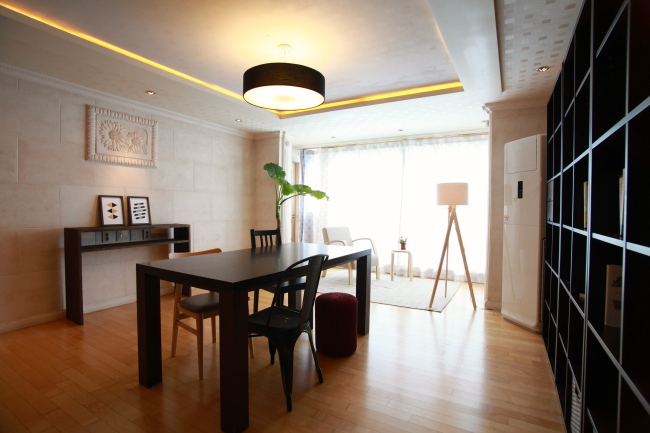
Sohaengju, a family shared housing unit (Kim Myung-sub/The Korea Herald)
An upscale apartment overlooking the Hangang River in Mapo, Seoul, is home to eight women who have a special interest in films.
Rent on a flat of a similar size averages 3.5 million won ($3,230) per month with a 100 million won deposit. But they pay only a fifth of the market price as they share facilities including bathrooms, kitchen and living room.
It is one of the nine apartment units leased by Woozoo, a shared housing company. Each unit has a particular theme for tenants, such as “start-up hopefuls,” “adventurers,” “film aficionados” and “culinary devotees.”
“Shared housing is in the initial stage of being introduced in Korea, but there has always been a high demand. Tenants can cut down on cost by splitting the rent, while leasers see 150-200 percent more profit than getting monthly rent from a family,” Kim Jeong-heon, company chief executive said.
Launched in 2013, the company remodels and re-leases “jeonse” houses ― a unique derivative of an old Korean system in which tenants live rent free for two years after paying a large deposit.
Rent fee varies by apartment conditions and locations, from 350,000 won to 650,000 won, plus a deposit of two months’ rent.
Woozoo’s cheap housing deal is sweeter for college students and office workers who cannot afford the skyrocketing price of monthly rent.
Seoul is a city notorious for high housing costs. According to the Ministry of Land, Infrastructure and Transport, Seoul’s average rent fee jumped from 289,000 won a month in 2006 to 421,000 won in 2012.
The tenants share not only costs and space but also their lives and interests.

The interior of one of Woozoo’s apartments
“Woozoo is not a real-estate business but it’s closer to a culture or community business,” Kim said.
“The real-estate market is going through difficult times. Leasers are hunting for new sources of profit and tenants want more elements that could enrich their living,” Kim said. “The two sides meet each others’ needs perfectly.”
The company is planning to re-lease 30 flats to some 200 people in their 20s and 30s this year.
Lee Seung-chul, a barista in Seoul, says he chose to move into an Woozoo apartment last September after his parents stopped paying for his housing after graduation.
“I wanted to live in Seoul but I realized getting a place was way too expensive,” Lee said.
“Sometimes, I end up spending more money than I initially planned when hanging out with my flatmates. But that doesn’t concern me since getting to know these people is more important for me.”
Community-focused life is embedded in the design of another shared housing apartment, run by a company called Sohaengju, in which nine households are living.
The first floor is used as a parking area and also a child-friendly open space. The second floor contains a common dining room, in which community meals are served every evening.
The spacious dining room is also used as a children’s play area, for intimate get-togethers and also for weekly classes, such guitar lessons. There are also woodworking and crafts rooms with a shared a bathroom on the second floor. The nine housing units are located from the third to sixth floors. The rooftop terrace contains communal and gardening areas.
There is also a common storage area located in the elevator hallway, where residents store some items such as suitcases, gardening tools or heaters, to share when they need.
“The whole idea was to foster interaction between residents,” said Park Heong-sup, co-founder of Sohaengju.
The idea was first started by parents who wished to raise their children together at a home.
“We all agreed to build a house where our children can be safe and play and enjoy more freely.”
The house was completed in 2011. It took nearly 10 months to complete the nine-unit apartment building ― three or four months longer than the ordinary construction process of a building that size because all residents put their input into the design.
Park said he believes the shared house is environmentally friendly and saves more space because of the shared facilities and amenities.
“I think one of the best advantages of living in the shared house is that parents can share child care burdens,” Park Jong-suk, 41, a mother of three, said.
Thanks to the large common areas and a strong connection between the residents, mothers often take turns looking after the children, she said.
“It’s really a big help. I think I could not possibly raise my three kids if I was living somewhere else,” she added.
The company has already built two more shared houses in and around Seoul, and the completion of the fourth house is due in September.
“We want to build more shared houses to allow the residents’ communal life be the focus. We want to make sure the house is more than just four walls to live in,” he added.
By Oh Kyu-wook and Suk Gee-hyun
(596story@heraldcorp.com)
(monicasuk@heraldcorp.com)







![[From the Scene] Monks, Buddhists hail return of remains of Buddhas](http://res.heraldm.com/phpwas/restmb_idxmake.php?idx=645&simg=/content/image/2024/04/19/20240419050617_0.jpg&u=20240419175937)